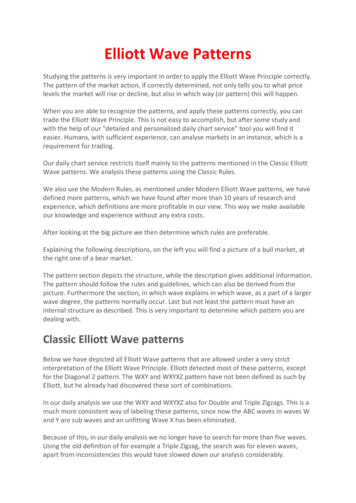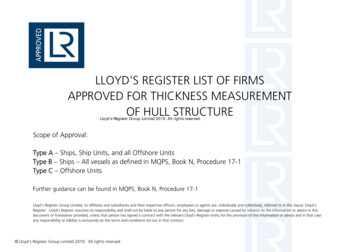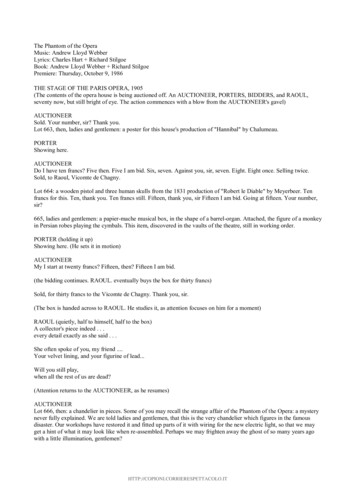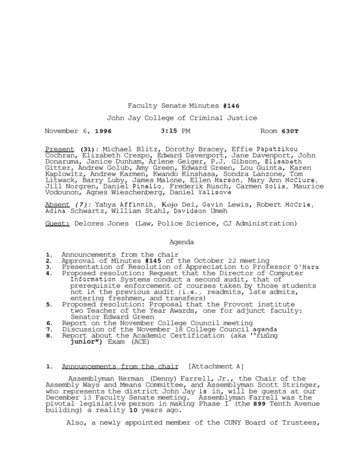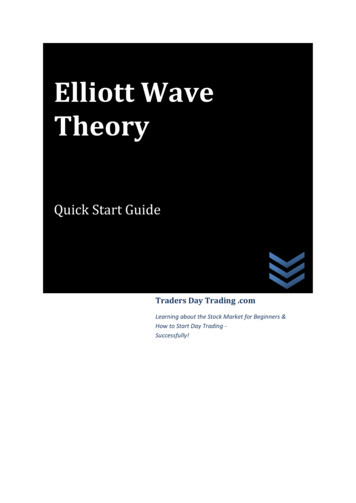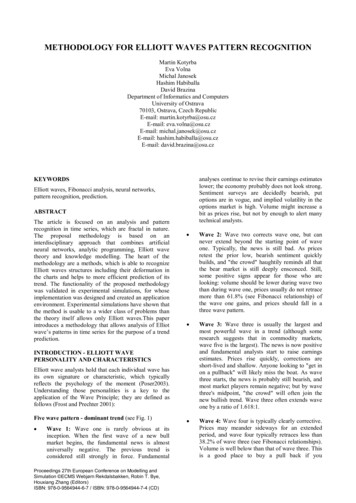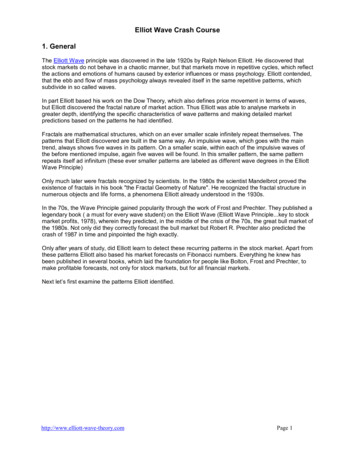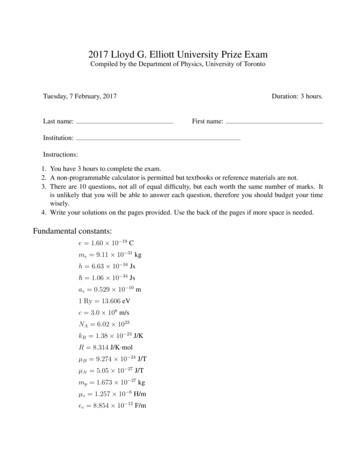
Transcription
2017 Lloyd G. Elliott University Prize ExamCompiled by the Department of Physics, University of TorontoTuesday, 7 February, 2017Last name:Duration: 3 hours.First name:Institution:Instructions:1. You have 3 hours to complete the exam.2. A non-programmable calculator is permitted but textbooks or reference materials are not.3. There are 10 questions, not all of equal difficulty, but each worth the same number of marks. Itis unlikely that you will be able to answer each question, therefore you should budget your timewisely.4. Write your solutions on the pages provided. Use the back of the pages if more space is needed.Fundamental constants:e 1.60 10 19 Cme 9.11 10 31 kgh 6.63 10 34 Js 1.06 10 34 Jsa 0.529 10 10 m1 Ry 13.606 eVc 3.0 108 m/sNA 6.02 1023kB 1.38 10 23 J/KR 8.314 J/K·molµB 9.274 10 24 J/TµN 5.05 10 27 J/Tmp 1.673 10 27 kgµ 1.257 10 6 H/m 8.854 10 12 F/m
page 2 of 312016 Lloyd G. Elliott University Prize Exam1. Three identical point masses M are joined to a common central point P by massless strings ofinextensible length L. Initially, one of the masses is held fixed and the other two masses are rotatedaround it with angular velocity ωi , as shown in the “before” figure below. The fixed mass is thenreleased. You may neglect gravity in this problem and assume all motion takes place in the plane.Assume that because the centre of mass and the axis of rotation are initially different the systemafter release will be unstable and will quickly adjust to the symmetric configuration shown in the“after” figure below, which shows the motion in the centre of mass coordinates of the system.(a) Calculate the system’s centre of mass velocity, and the system’s angular velocity ωf about itscentre of mass, after adjustment. (The initial angle between the two masses on the right in the“before” figure may be neglected.)(b) Suppose that the system is aimed at a target T located at a distance much greater than L: whatwould be the best strategy for hitting T? In your answer, use the strategy of aiming the CoMof the system at T. If the system is released when the strings are horizontal (as pictured),describe the subsequent motion of the centre of mass.ωfωiLLLafter (CofM frame)before2
page 3 of 312016 Lloyd G. Elliott University Prize Exam3
page 4 of 312016 Lloyd G. Elliott University Prize Exam4
page 5 of 312016 Lloyd G. Elliott University Prize Exam2. An airplane is flying in a straight line at a constant height h above the ground. The speed of theairplane, v, is much less than the speed of sound, vs 343 m/s.(a) Treating the engine sound as though it has a single well-defined frequency f (the frequency inthe rest frame of the airplane), show that an observer on the ground, directly under the path of theairplane, who measures the period Tobs of the arriving sound waves, will obtain a frequencyfobs 1 Tobs1 f )2 h2(x v/f vs /f (x2 h2 )vs /f where the x is the horizontal distance between the observer and the airplane when the sound isemitted.(b) Show that in the limit x h, fobs reduces tofobs f .1 v/vs(c) Sketch a plot of f (x) vs. x from part (a), assuming that f 200.0 Hz, v 50.0 m/s andh 500.0 m.(d) If you could accurately measure frequency vs. time, explain how you could tell how highoverhead an airplane has passed (i.e. determine h)?5
page 6 of 312016 Lloyd G. Elliott University Prize Exam6
page 7 of 312016 Lloyd G. Elliott University Prize Exam7
page 8 of 312016 Lloyd G. Elliott University Prize Exam3. An ideal compressor can be visualized as working in three steps: (i) starting with zero volume,an intake valve is opened to the atmosphere and then a piston is withdrawn so that air enters thecompressor at 300 K and a fixed pressure of 1 atmosphere; (ii) the intake valve is closed and thenthe piston compresses the gas adiabatically to 2 atmospheres, and (iii) an outlet valve is openedand then the piston continues to advance, so that all of the compressed air, at a fixed pressure of 2atm, is delivered to a pipe. Assume that all three steps are carried out reversibly (this being an idealcompressor).(a) Draw the p, V diagram of this Rprocess, and use this diagram to explain why the net work doneby the compressor is equal to V dp.(b) Show that this work is equal to the change in the enthalpy of the gas between steps (i) and(iii), and carry out the integral to show thatNet work by compressor γ(pf Vf pi Vi ) ,1 γwhere γ is the rato of the specific heat at constant pressure to that at constant volume.(c) If the compressor consumes 200 W of useful power, what volume of air will it deliver persecond? [Assume γ 1.4. 1 atm of pressure is approximately 1.0 105 Pa.]8
page 9 of 312016 Lloyd G. Elliott University Prize Exam9
page 10 of 312016 Lloyd G. Elliott University Prize Exam10
page 11 of 312016 Lloyd G. Elliott University Prize Exam4. Positronium is a hydrogen-like system consisting of an electron and a positron bound together bythe Coulomb interaction. Electrons and positrons have identical mass and spin ( 12 ). Their chargesare equal in magnitude, but opposite in sign.(a) The binding energy of a hydrogen atom depends only on (i) the reduced mass of the electronproton system, (ii) the speed of light, and (iii) the dimensionless fine structure constant, α ( 1/137). Using dimensional analysis (or your alternative favourite method), estimate how theenergy of the 1S – 2P transition in hydrogen scales with the mass of the electron.(b) Given that a hydrogen atom in its 2P state radiates a photon with a wavelength of 121.5 nmwhen it decays to the 1S state, what is the wavelength of the light emitted by a positroniumatom when it decays from its 2P state?(c) Just as in hydrogen, the energy eigenstates of the positronium atom can be labeled by the orbital angular momentum of the electron and positron, and their total spin angular momentumS. What values can the total spin S of the electron and positron take?(d) Electrons and positrons can be modeled as spinning charge distributions, and they have permanent magnetic moments due to their spin. The magnetic moment of an electron is -1µB . What is the magnetic moment of a positronium atom due to the spins of the electron andpositron?11
page 12 of 312016 Lloyd G. Elliott University Prize Exam12
page 13 of 312016 Lloyd G. Elliott University Prize Exam13
page 14 of 312016 Lloyd G. Elliott University Prize Exam5. A top quark, with a mass mtop 172.5 GeV/c2 , is produced in a proton-proton collision. It decaysinto a bottom quark and a W intermediate vector boson.(a) If the top quark is produced at rest, what is the energy of the bottom quark? Assume that thebottom quark is massless and the W boson has a mass mW 80 GeV/c2 .(b) If the top quark is produced with a momentum of 100 GeV/c, what is the minimum momentum of the bottom quark?(c) The bottom quark in (b) decays a picosecond after being produced, as observed in its restframe. The mass of the bottom quark is 5 GeV/c2 (small enough that we could ignore it inthe answers to (a) and (b)). What is the minimum distance the bottom quark travels in thelaboratory frame? What is the maximum distance?14
page 15 of 312016 Lloyd G. Elliott University Prize Exam15
page 16 of 312016 Lloyd G. Elliott University Prize Exam16
page 17 of 312016 Lloyd G. Elliott University Prize Exam6. One way of representing simple harmonic oscillation is using the complex ordinary differentialequationdZ iωZ,(1)dtwhich has solution Z(t) Z(0)eiωt . Suppose we want to test different computer time steppingalgorithms by applying a finite difference approximation to this system.(a) The Euler forward method replaces the ordinary derivative on the LHS of (1) with a finitedifference approximation as follows:dZZ(t δt) Z(t) .dtδtThe RHS is evaluated at time t, resulting inZ(t δt) Z(t) iωZ(t).δt(2)This is a pretty good approximation as long as δt ω 1. Given Z(t 0), develop analgorithm to calculate Z(nδt) using this approximation. Can you identify a problem withapplying Euler forward to this system?(b) In the implicit method, we replace (2) with the following:Z(t δt) Z(t) iωZ(t δt).δt(3)Calculate Z(nδt) given Z(t 0) for the implicit method. Do you see a potential problemwith applying the implicit method to this system?(c) Can you come up with a method along similar lines of those in a) and b) but does not sufferfrom the problems you identified?17
page 18 of 312016 Lloyd G. Elliott University Prize Exam18
page 19 of 312016 Lloyd G. Elliott University Prize Exam19
page 20 of 312016 Lloyd G. Elliott University Prize Exam7. The Navier-Stokes equation, neglecting gravitational or other body forces, is given byu u1u p ν 2u u · u tρwhere u is the fluid velocity, p is the fluid pressure, ρ is the density and ν is the kinematic viscosity.The mass continuity equation is given by ρu) 0. · (ρu tA fluid of constant density and viscosity is located in the space between infinite concentric cylindersthat are coaxial with the z axis. The inner cylinder has radius r1 and is moving at a steady velocityUz in the ẑ direction. The outer cylinder has radius r2 r1 and is at rest.(a) Determine the velocity u (r, φ, z) for the fluid at steady state, where in cylindrical coordinates(r, φ, z) are the radial, azimuthal and vertical coordinates. In addition, the fluid velocity isu (ur , uφ , uz ) and the gradient, Laplacian, and divergence are 1 ,,, r r φ z 21 1 22and r 2 2 2r r rr φ z1 (rAr ) 1 Aφ Az ·A ,r rr φ zwhere in the last equation A (Ar , Aφ , Az ) is any vector field and its cylindrical coordinatecomponents. Assume no external pressure is applied, that all fields are indepenent of φ, andthat u is independent of z. State any other assumptions you make.(b) The shear stress normal to the surface of a cylinder is the viscousforce per unit area. In urz .Whatis the force per unitcylindrical coordinates, it is given by τzr 2ρν u r zlength along the z axis required to maintain the motion of the inner cylinder?20
page 21 of 312016 Lloyd G. Elliott University Prize Exam21
page 22 of 312016 Lloyd G. Elliott University Prize Exam22
page 23 of 312016 Lloyd G. Elliott University Prize Exam8. X-ray free-electron lasers (XFELs) are capable of producing 40 femtosecond pulses of x-rays, tunable between a few hundred eV and more than 10 keV in photon energy. Typical beam parametersare a beam diameter of 400 µm and 3 mJ of photons per pulse.(a) Star Trek IV – The Voyage Home contains a scene in which Chief Engineer Scotty proposes tomake a whale tank out of ‘transparent aluminum’. XFELs are capable of making transparentaluminum, very briefly, by saturable absorption: promoting virtually all the innermost boundelectrons to unbound states.For a solid aluminum foil 100 nm thick, what intensity of x-rays can produce this in a singlepulse? How does this intensity compare to the natural XFEL beam (parameters given above),if the beam is uniform in space and time.You may assume the pulse duration is much less than the average time for the electrons torecombine.(b) Such beams can be focussed, using special lenses. Well above the K-edge energy, the dielectric function of a metal may be represented as a free-electron gas, or plasma, having thefunctionN e21 1 ,2 m ω 1 iγ/ωwhere Ne is the number density of electrons, me is the mass of the electron, ω is the angularfrequency of the x-rays, γ is the collision rate for electrons, and you may assume γ/ω 1.If one makes from beryllium a spherical-surface lens 400 µm in diameter, what is the shortestfocal length it will have, for 5 keV photons? Give details of the shape of your lens.If multiple such lenses can be used, how many lenses used together make a focal length of 1m?(c) What is the fundamental physical limit to the smallest size of focal spot that might be formed?Potentially useful information:Some properties of Al: K-edge energy 1.5596 keV; density ρ 2.70 g/cm3 ; mass of oneAl atom 4.48 10 23 g; mass absorption coefficient (at 1.5596 keV) µ/ρ 3.621 102cm2 /g.Some properties of Be: K-edge energy 0.115 keV; density ρ 1.85 g/cm3 ; mass of one Beatom 1.50 10 23 g; mass absorption coefficient (at 5 keV) µ/ρ 4.369 100 cm2 /g.23
page 24 of 312016 Lloyd G. Elliott University Prize Exam24
page 25 of 312016 Lloyd G. Elliott University Prize Exam25
page 26 of 312016 Lloyd G. Elliott University Prize Exam9. A 10 kg sphere of 60 Co is moving at a velocity of 100 m/s in intergalactic space, according to aninertial observer. Cobalt-60 is radioactive, with a half-life t1/2 1.6 108 s, and each nucleardecay emits gamma rays with an energy of 2.5 MeV. According to the observer, the gamma rayshave a Doppler shift that depends on the direction in which they are emitted.(a) Show that the net force exerted by the gamma rays on the sphere isṄ ωF 2 v ,cwhere Ṅ is the number of decays per second from the Co nuclei in the rest frame of thesphere, ω is the energy of the gamma rays, and v is the velocity of the Co sphere.(b) Show that, despite this force, the sphere does not slow down.26
page 27 of 312016 Lloyd G. Elliott University Prize Exam27
page 28 of 312016 Lloyd G. Elliott University Prize Exam28
rpage 29 of 312016 Lloyd G. Elliott University Prize Exam10. A toy model of lattice vibrations (i.e. phonons) in a crystalline solid treats the crystal as an infinitelinear chain of atoms in which each atom interacts only with its nearest neighbour atom, via alinear spring of spring constant k, as shown below. The equilibrium position of the the nth atomin the chain is na, where a is the lattice constant, and xn is the displacement from this equilibriumposition, along the chain direction. Each atom has the same mass, m.(n 1)anaxn 1k(n 1)axn 1xnkkk(a) Write the equation of motion of the nth at
2017 Lloyd G. Elliott University Prize Exam Compiled by the Department of Physics, University of Toronto Tuesday, 7 February, 2017 Duration: 3 hours. Last name: First name: Institution: Instructions: 1.You have 3 hours to complete the exam. 2.A non-programmable calculator is permitted but textbooks or reference materials are not. 3.There are 10 questions, not all of equal difficulty, but each .
